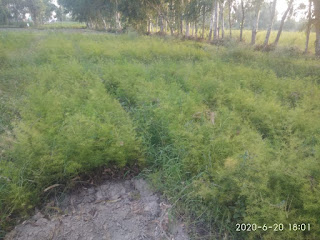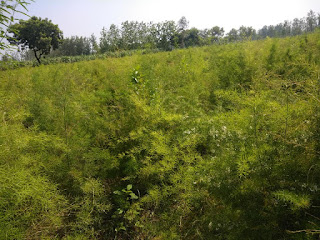How to cultivate Nepali Yellow Satavar( Asparagus Racemosus) in Farm
Satavar or Shatavari is an Ayurvedic herb whose botanical name is Asparagus Rasemosus. Nepali pili Satavar is a special variety of Satavar or shatavari which is grown on a large scale in India and Nepal as it gets good commercial value in the market. this medicinal crop can be grown easily in tropical and subtropical region, particularly in central India. This is a multi-year crop that grows in 18 months to 30 months. The yield per hectare of Shatavari also varies according to the soil fertility and the climatic condition of the area. After obtaining roots from the ground they can be stored upto 10-15 years. Farmers are switching to farming of shatavari from conventional farming of cereals due to multi fold return.
1. Soil and climate condition for farming
The sandy loam is best suited for its cultivation. But it is necessary
to have fertility in the soil, whose value of index is around 6.0 - 7.5.
The plains are considered more suitable for the cultivation of satavar. The
land and climate of the states like Maharashtra, Gujarat and Uttarakhand are
quite favorable for the cultivation of satavar or shatavari. It is implanted in
fields from July to September.
2. Preparation of land for cultivation
The land should be given deep ploughing. The first plowing of the field should be done with a
soil-turning plow so that the grass and other crop residues are buried in the
soil. Thus, 4-5 ploughing or tillage are required. There should not be any lump of clay in the field. The identity of
the prepared land is believed to be brittle.
3. Varieties of Satavar
Varieties of Asparagus can be grown locally as found. Nepali pili (yellow) Satavar is an advanced variety that grows more branches. The dry roots of Nepali Satavar are in great demand in Ayurvedic medicines and health food or FMCG companies which use dry roots of Satavar as the main ingredient. Shatavari vine is another variety of Satavar which is used in garden or home for natural beauty.Generally nepali yellow satavar or shatavari is cultivated widely due to its good commercial value.
4. Seed sowing and time
The sowing of seeds mainly starts from April to prepare the saplings/plants of Satavar i.e. Nursery. Seeds starts germinating withing 20 days. In 3
to 4 months, the Satavar plants nursery is ready and they can be implanted in
the main field in July - September.
5. Method of implanting the plants in the main field
Before implanting the plants, make thick rams in the beds and
press plants 15 cm inside. While implanting the plants, the distance from plant
to plant and row to row should be kept 2 feet so that there should not be any hindrance in
plant's growth and the plants will be larger after maturity. Proper management of
irrigation should be done so that plants get moisture and Growth should not be
affected.
6. Amount of manure and fertilizer
Asparagus is a medicinal plant, so indigenous manure is used in its production. Rotten manure of animals dung should be given 12-15 tons per hectare and we should avoid NPK(Nitrogen, Phosphorus and Potassium) or DAP( Diammonium Phosphate). This quantity should be given 15 days before field preparation or planting.
7. Management of irrigation
Satavar cultivation requires less irrigation than cereal crops. First irrigation should be given immediately after transplanting. In summer irrigation can be given twice a month and in winter once a month and there is no need of irrigation in rainy season generally.
8.Weeding hoeing and Soil Plating
This crop is a multi-year crop which must be planted once a year. Weeding – hoeing is needed when field gets weeding. The best time to soil plating is February-March as the weather changes after March and the plants grow more so that the stems or branches can grow in greater quantity.
9. Crop harvesting
Irrigate the field before digging the roots of the moth, which
makes the land moist and it is easy to remove the roots from the land. The
roots should be carefully removed with the help of a spade or Kudal. The roots
of matured satavar are extracted from the field, washed in water and then
boiled. The rind above the roots is poisonous so it is separated from the tuber
or lump. After boiling, the roots are peeled and dried in light sunlight.
10. Yield
The yield of this medicinal crop depends mainly on the local climatic conditions and the soil fertility of the farm. Wet tuberous roots yield approximately 12% - 20% dried roots and up to 50 to 60 quintals on an average can be obtained per hectare. Upto 2 quintals seeds can be obtained from field. Dried roots in the size of 5-10 cm*1-2 cm are marketed as 'A' grade variety.
11. Diseases and Pest Control
Generally, moth does not bear pests as it is a medicinal plant.
Spraying of fungicide can be done. To reduce the cost of the cultivation,
farmers also co-grow turdal, capsicum or vegetables etc.










Very informative post! What to do if we want to send Shatavari in Canada?
ReplyDelete